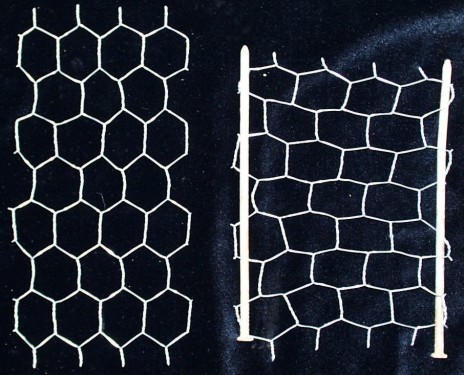Demonstrating Poisson's Ratios with Chicken Wire
The lateral expansion or contraction of a material as it is stretched can be bescribed by a mathematical relation called the Poisson's ratio. Most materials tend to contract laterally as they are stretched (and have a positive Poisson's ratio), but some materials expand laterally as they are stretched (and have a negative Poisson's ratio). Often a material that has a positive Poisson's ratio can be modified to form a structure that has a negative Poisson's ratio. Chicken wire can be used to demostrate these ratios. Caution: Cut chicken wire can be sharp!
References:
Campbell, D. J.;Querns, M. K. "Using Paper Cutouts to Illustrate Poisson's Ratio." J. Chem. Educ., 2002, 79, 76.
For instructions on how to make fullerene models out of chicken wire, see Murphy, C. J.; Campbell, D. J. "A Chicken Wire Buckyball." Chem. Educator 2000, 5, 1.
 ABOVE: Positive Poisson's ratio structures (LEFT) unstreched and (RIGHT) stretched.
ABOVE: Positive Poisson's ratio structures (LEFT) unstreched and (RIGHT) stretched.
 ABOVE: Negative Poisson's ratio structures (LEFT) unstreched and (RIGHT) stretched.
ABOVE: Negative Poisson's ratio structures (LEFT) unstreched and (RIGHT) stretched.




No comments:
Post a Comment